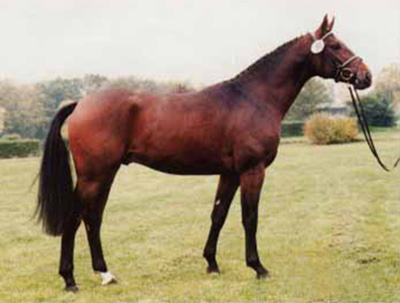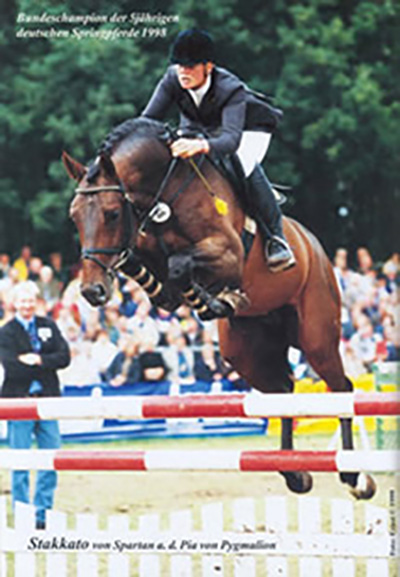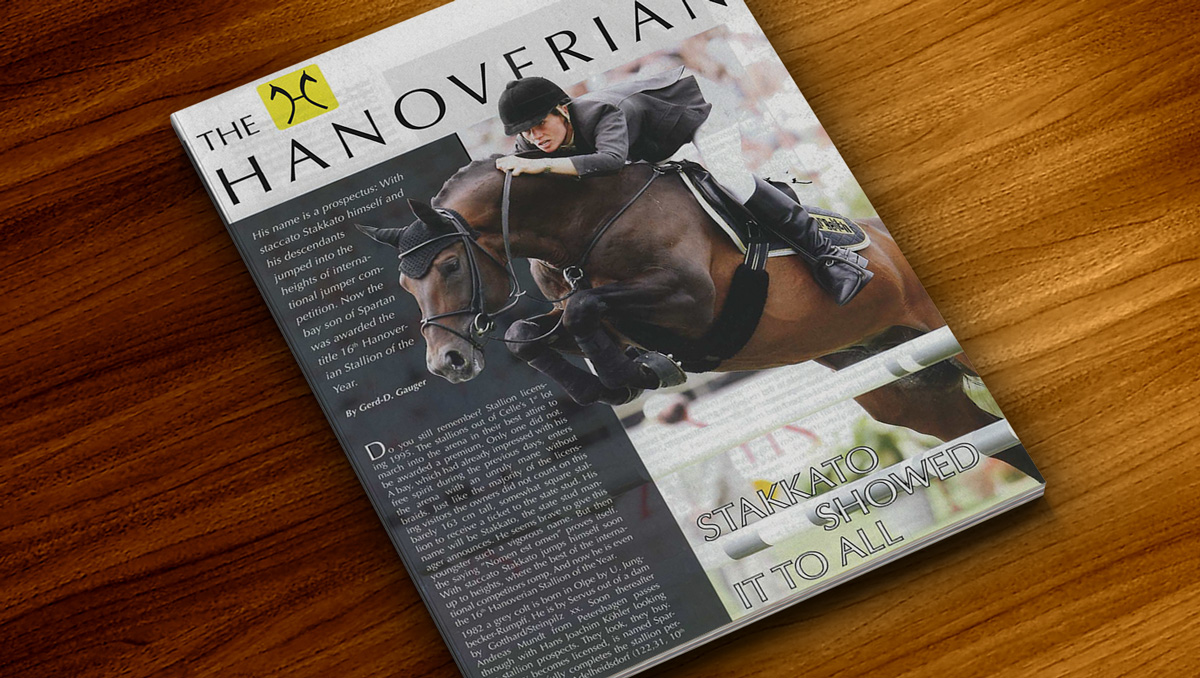Servus, Gotthard, Steinpilz xx Bloodline



1993 16 hh Brown Stallion
Spartan x Pia
Stakkato created a sensation at his first appearance at the Bundeschampionate back in 1998. So wonderful was his jumping style that the judges wanted to give him a 10 – until one pointed out that one tiny part of the young stallion’s tongue was visible on one side of his mouth!!! So they had to settle for a 9.9.
Stakkato comes from an illustrious jumping family – although his sire, Spartan was almost lost to the German breeding industry, having been sold to the United States! Discovered by Hans-Joachim Köhler, Spartan was sold as a yearling to Mr. and Mrs. Himmelmayer of Virginia, USA.
Spartan returned to Germany and passed his performance test with the impressive jumping index of 130.26 (dressage index – 111.41) and an overall score of 122.31. From 1985 until 1991, Spartan stood in Canada and the US, and competed in jumping classes to Grand Prix level with Sasha Himmelmayer. He then returned to Germany to stand at Andreas Mundt’s farm in Petershagen, where he is a licensed stallion with the Hannoverian, Oldenburg and Westfalien studbooks.
According to Siefried Putscher: “His children inherited elastic movement, with an energetic push from their hindquarters, excellent rideability, performance willingness as well as a lot of jumping talent and great intelligence. ‘The Spartans learn quickly’, that is what you hear in rider circles.”
Spartan is by Servus (Sesam I/Dominus/Goldfisch II) of the Trakehner Semper Idem line. Servus produced a number of successful jumpers as well as the international dressage competitor, Slivowitz. Spartan’s dam is Gottilde, by the jumping foundation sire, Gotthard, and out of a truly great mare, Steingilde (by the Thoroughbred, Steinpilz xx out of S26287, a heavier mare by Elsass, a grandson of Abendsport.) Spartan died of a heart attack in March 2000 at the age of 18.
Stakkato, Spartan’s most noteworthy son to date, is out of Pia by Pygmalion (Patras/Absatz). Pygmalion stood at the Köhler stud in Verden. His sire, Patras was a very noble and strong Trakehner, clearly influenced by Arabian and English Thoroughbred blood.
Stakkato showed his wonderful jumping ability at his Performance Test, recording a jumping index of 144.39, before going to the Bundeschampionate, where his exceptional style produced the 9.9 result under the guidance of amateur rider Eva-Maria Bitter.
The Stud Director at Celle, Dr Bade is no fan of the policy of taking breeding stallions out into competition. “You will not change a stallion in his heritability by putting him into competition… If you take semen on the Monday and look at the microscope, you can see by the quality of the semen if the horse has been competing at the weekend.” But in Stakkato’s case, Dr Bade was forced to make an exception: “He is such a type that I think the breeders would say ‘you can talk of his jumping ability but he is not our type’, but after Eva-Maria Bitter competes with him, then the breeders want to use him.”
In 2002 and 2003 Stakkato headed the German jumping index, a situation which provoked heated comment from Henk Bouwman in Z Magazine (February / March edition – info from www.zangersheide.com ) who suggested “it demonstrates what is the archilles heel of the estimated breeding value. Stakkato will be a 10 years old next April 4 and because 1997 was his first breeding season, his eldest offspring will be 5 year-olds this spring. Nevertheless he already has a breeding value for showjumping of 169, well above proven runner-up Carthago Z (born 1987) with 156 and six sires with a breeding value of 154: Caretino (1983), Contender (1987), Cassini I (1988), Perpignon (1991) and Acorado (1994). The birth years show, as a matter of fact, that Stakkato is not the only one in the top of the breeding value list whose eldest offspring were 4 year-olds in the season 2002, therefore not allowed to start in the cycle for young horses. In Germany only 5 and 6 year old horses may start for this event. The same goes for Acorado. Conclusion: the breeding values of Stakkato and Acorado are not derived from the performance of their offspring.”
It may well be that Stakkato will prove to be a very important sire of jumping horses, but until his progeny are out and performing this will remain speculation. Perhaps the Hannoverian breeding rating based as it is on mare and auction horse inspections is a more reliable guide to Stakkato’s worth as a sire, and it should be noted that in the 2002 yearbook his progeny achieve the very high rating of 180 for their jumping ability and a respectable 115 for their dressage.. In keeping with Dr Bade’s worries about type, his offspring have a very poor rating of 74 for their conformation – although it should be noted that Dr. Ludwig Christman of the Hannoverian Verband has found a negative correlation between jumping ability and scores for type.
As a performer himself, Stakkato has been quite successful with winnings to date of 26,190 Euro. After his triumphs at the Bundeschampionate he was 6th in the Youngster Final in Spangenberg (2000), 3rd in the Frankfurt Grand Prix (2001), 3rd in the Nations Cup of Lummer (2002) and 5th in the Hamburg Ladies Cup (2002), Stakkato is the sire of three licensed sons at the State Stud Celle – the best performed being Stolzenberg, who with a score of 141.88 was the best jumper of his performance test.
VIDEO
MEDIA

Hannoveraner Verband Newsletter |
PEDIGREE
| Spartan | Servus | Sesam | Senator |
| Abendquelle | |||
| Dombucht | Dominus | ||
| Goldseele | |||
| Gottlinde | Gotthard | Goldfisch II | |
| Ampa | |||
| Steingilde | Steinpilz | ||
| Elsass Mare | |||
| Pia | Pygmalion | Patras | Index |
| Patria Nova | |||
| Albalonga | Absatz | ||
| Adlerfee | |||
| Goldfeeder | Goldstern | Gotthard | |
| Waidgefaehrtin | |||
| Wjatka | Wittelsbach | ||
| Valetta |



